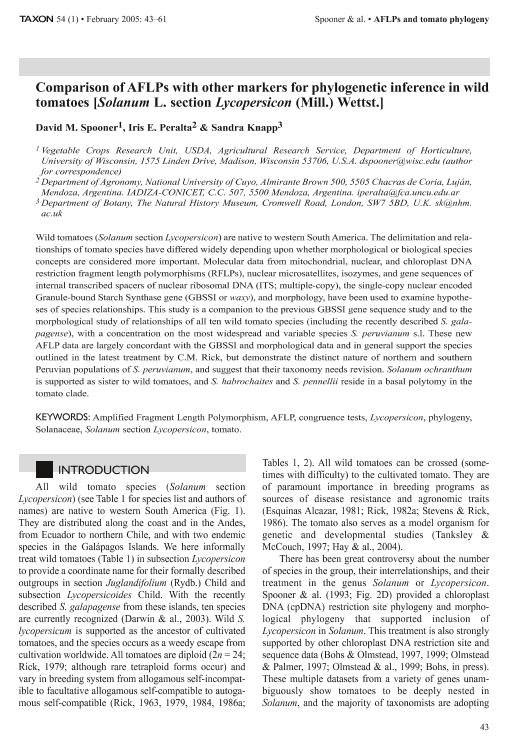Artículo
Comparison of AFLPs with other markers for phylogenetic inference in wild tomatoes [ Solanum L. section Lycopersicon (Mill.) Wettst.]
Fecha de publicación:
02/2005
Editorial:
International Association for Plant Taxonomy
Revista:
Taxon
ISSN:
0040-0262
Idioma:
Inglés
Tipo de recurso:
Artículo publicado
Clasificación temática:
Resumen
Wild tomatoes (Solanum section Lycopersicon) are native to western South America. The delimitation and relationships of tomato species have differed widely depending upon whether morphological or biological species concepts are considered more important. Molecular data from mitochondrial, nuclear, and chloroplast DNA restriction fragment length polymorphisms (RFLPs), nuclear microsatellites, isozymes, and gene sequences of internal transcribed spacers of nuclear ribosomal DNA (ITS; multiple-copy), the single-copy nuclear encoded Granule-bound Starch Synthase gene (GBSSI or waxy), and morphology, have been used to examine hypotheses of species relationships. This study is a companion to the previous GBSSI gene sequence study and to the morphological study of relationships of all ten wild tomato species (including the recently described S. galapagense), with a concentration on the most widespread and variable species S. peruvianum s.l. These new AFLP data are largely concordant with the GBSSI and morphological data and in general support the species outlined in the latest treatment by C.M. Rick, but demonstrate the distinct nature of northern and southern Peruvian populations of S. peruvianum, and suggest that their taxonomy needs revision. Solanum ochranthum is supported as sister to wild tomatoes, and S. habrochaites and S. pennellii reside in a basal polytomy in the tomato clade.
Archivos asociados
Licencia
Identificadores
Colecciones
Articulos(IADIZA)
Articulos de INST. ARG DE INVEST. DE LAS ZONAS ARIDAS
Articulos de INST. ARG DE INVEST. DE LAS ZONAS ARIDAS
Citación
Spooner, David M.; Peralta, Iris Edith; Knapp, Sandra; Comparison of AFLPs with other markers for phylogenetic inference in wild tomatoes [ Solanum L. section Lycopersicon (Mill.) Wettst.]; International Association for Plant Taxonomy; Taxon; 54; 1; 2-2005; 43-61
Compartir
Altmétricas




